
Perez and Verstappen annihilate the competition in the race in Jeddah. Ferrari from bad to worse…
On the very fast street circuit of Jeddah we witnessed an undisputed victory for Red Bull: Perez kept his pole position and went on to win undisturbed, while Verstappen climbed up from 15th position in qualifying to second place, beyond a Safety Car on lap 17 which favored his comeback - but which didn't change the final outcome of the race.
Zak Mauger / Motorsport Images
Here's the classification of the Gran Prix:
- Sergio Perez (Red Bull)
- Max Verstappen (Red Bull)
- Fernando Alonso (Aston Martin)
- George Russell (Mercedes)
- Lewis Hamilton (Mercedes)
- Carlos Sainz (Ferrari)
- Charles Leclerc (Ferrari)
- Esteban Ocon (Alpine)
- Pierre Gasly (Alpine)
- Kevin Magnussen (Haas)
- Yuki Tsunoda (Alpha Tauri)
- Nico Hulkenberg (Haas)
- Zhou Guanyu (Alfa Romeo)
- Nyck de Vries (Alpha Tauri)
- Oscar Piastri (McLaren)
- Logan Sargeant (Williams)
- Lando Norris (McLaren)
- Valtteri Bottas (Alfa Romeo)
- Alex Albon (Williams, DNF)
- Lance Stroll (Aston Martin, DNF)
From a strategic point of view, the race was run on a single pit stop, the timing of which was however dictated by the aforementioned Safety Car on lap 17, called on the track after Lance Stroll stopping due to a problem with his Power Units. Much was said about the decision to trigger the SC in a low-risk situation, but it later emerged that the reason for the such call was the obstruction of the marshals' area by the same Stroll's Aston Martin. The car therefore did not constitute a danger in itself, but made further assistance impossible: therefore the decision to neutralize the race was right.
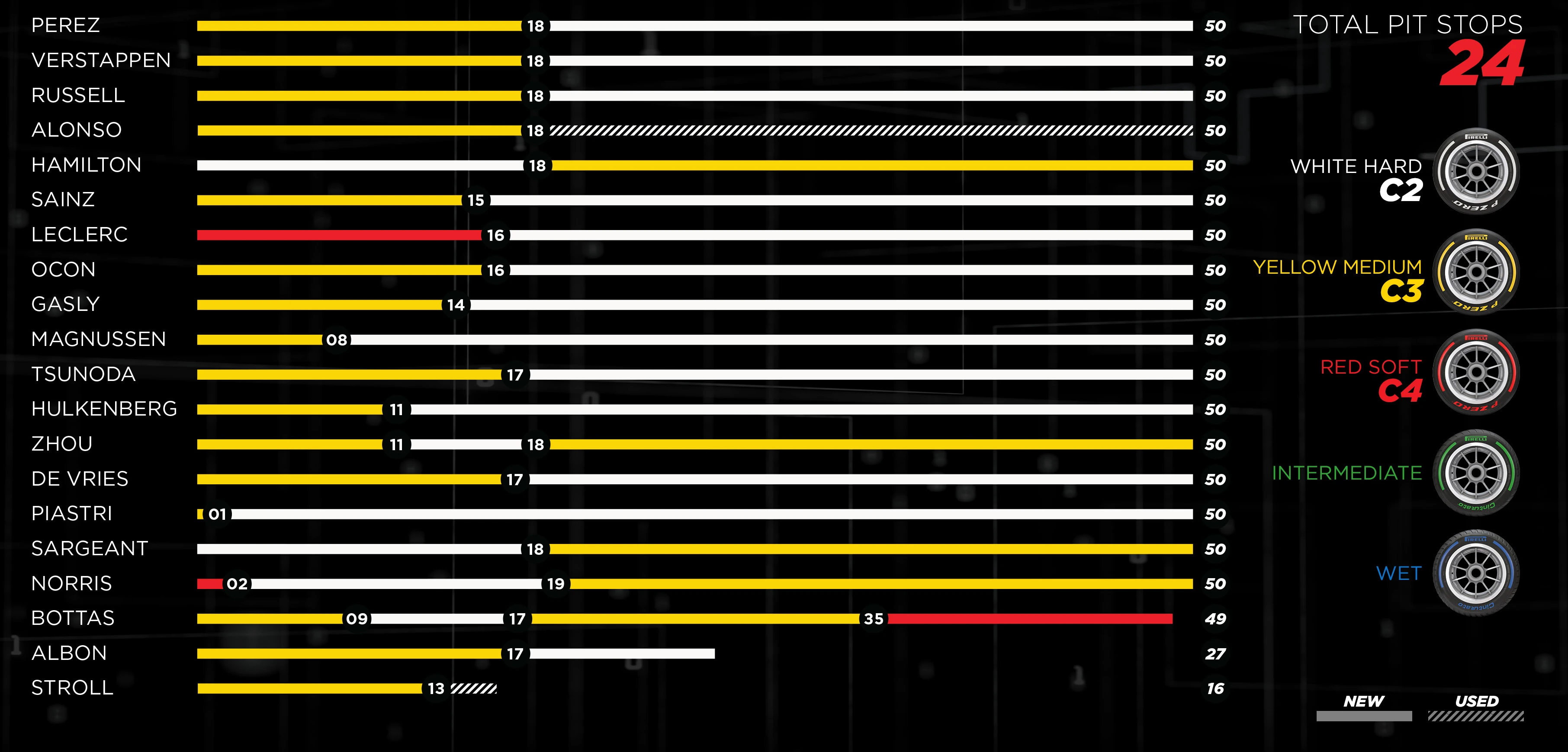
Strategies adopted by each team (Twitter / Pirelli Motorsport)
The tyre choice for almost all the front runners fell on the harder compounds, certainly more durable over long stints compared to the soft ones which, for example, Charles Leclerc was forced to use - in an attempt to recover positions starting from the 12th slot on the grid.
Mark Sutton/Motorsport Images
Performance analysis of the Grand Prix: what can we find out from the race paces?
So let's analyze the race pace held by the first 8 classified throughout the Grand Prix, to understand what performances to expect in tracks similar to Jeddah, i.e. with low tyre degradation, long straights and very high speed corners:
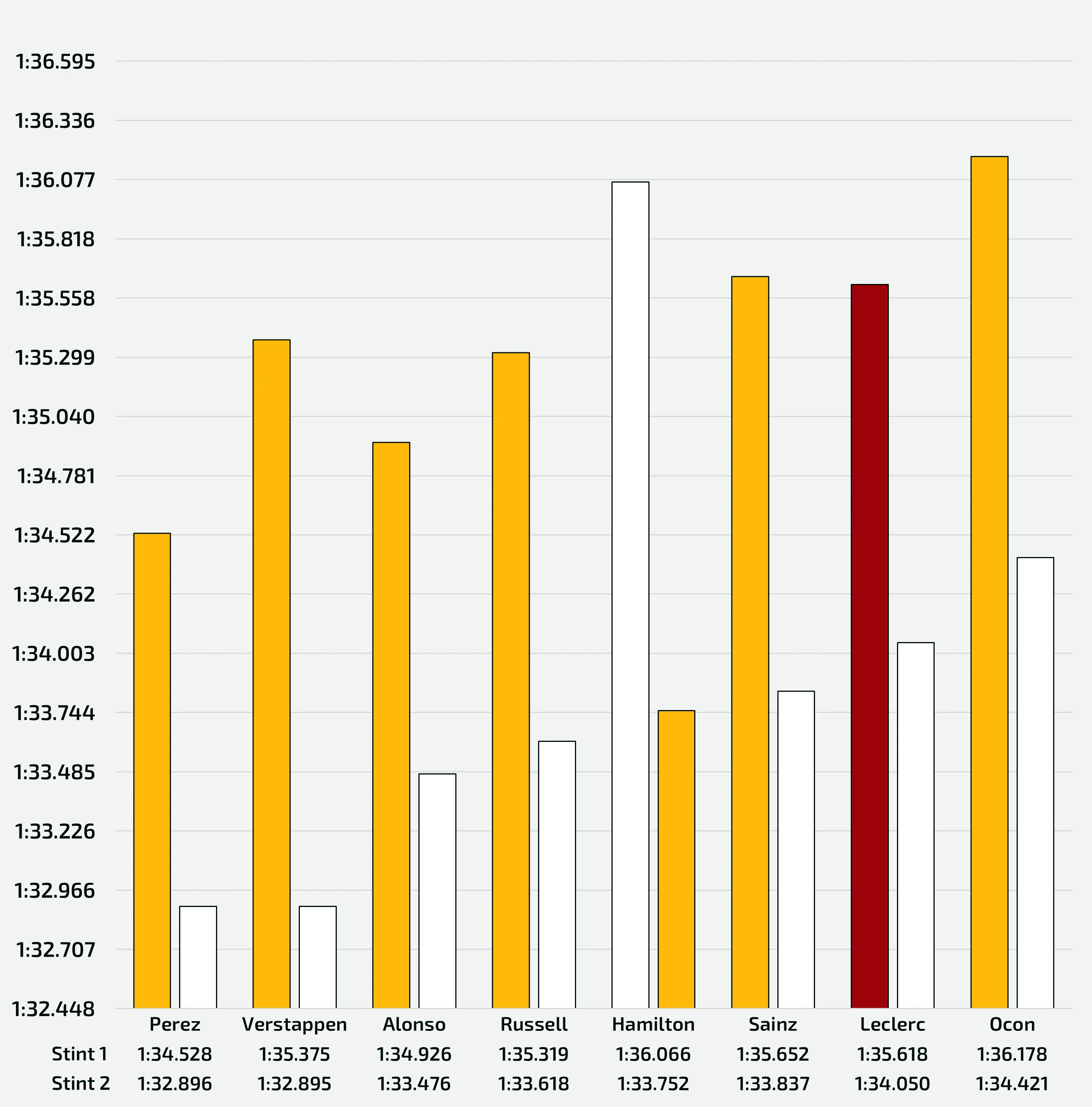
Race pace held by the first 8 classified, divided by stint
The first stint can be analyzed taking into account two factors that contributed a lot to the economy of the race:
- Fernando Alonso, who got off to a good race start, after taking the lead in turn 1, held the lead for 4 laps, until Perez overtook him thanks to the amazing top speed of his RB19. From that moment on, Fernando managed to stay in the DRS zone of Checo for 5-6 laps, a factor that allowed him to drive more than half a second per lap faster than he would have done in clean air; once he came out of the 1.0 s threshold, his performances physiologically - and strategically - dropped, but by that point he had already gained a safety gap buffer on his first pursuer, George Russell;
Zak Mauger / Motorsport Images
- Leclerc (12th at the start) and Verstappen (15th at the start) went through two comebacks in their first stints, where judging their pace is very difficult: if on the one hand the DRS zones allowed them to gain laptime, on the other sitting behind slower cars for some laps certainly didn't do them any favors - neither at their tyre temperatures, nor consequently at their laptimes;
The second and final stint of the race, on the other hand, was run by all but Hamilton on Hard tires (Lewis, having used them in the initial part of the race, then switched to Medium tyres). That's where the true Red Bull's performance emerged: starting from a regrouped group situation after the Safety Car, Verstappen immediately got rid of Russell and Alonso, placing himself behind his teammate Perez with a gap of 5.8 s from him.
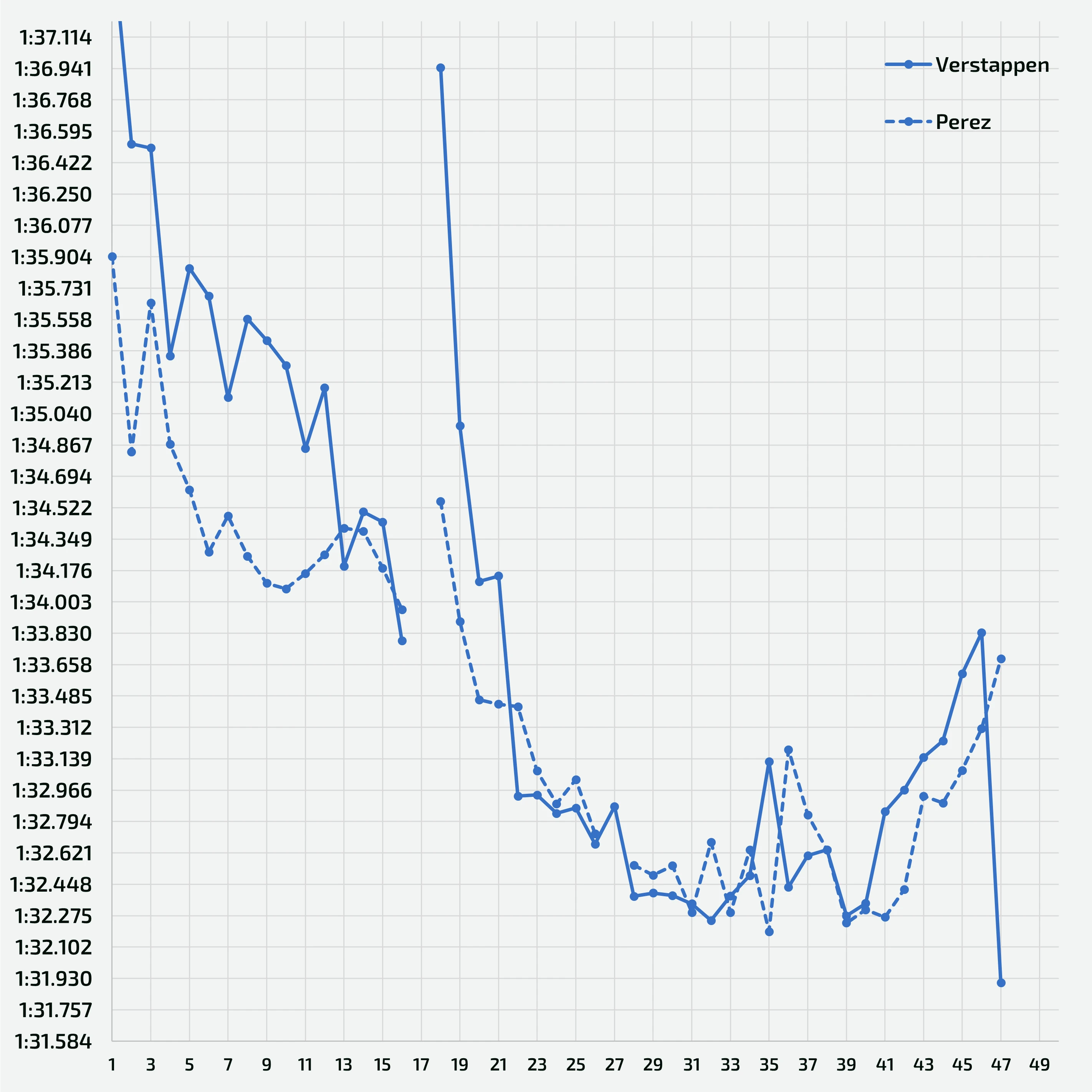
Laptime comparison between Sergio Perez and Max Verstappen
From that moment on, a forcing began on both sides, with Max wanting at all costs a victory that would have something legendary, having started in 15th. "Checo" Perez, for his part, had no intention of giving up the leadership of the Grand Prix held for so long... I'm sure that Red Bull engineers on the pit wall weren't too happy with the pace held in the second part of the race: it is known that, when a team is so dominant, it's better not to show its full potential to prevent those who govern the sport from deciding to change the regulations and reshuffle the playing field.
Sam Bloxham/Motorsport Images
It's the history of Formula 1, it's always been like this... Only 9 years ago, in 2014, Mercedes was on its way to dominate the Turbo-Hybrid era by hiding an advantage that was even more significant than the race results let us imagine!
Aston Martin now second force, surprise Mercedes ahead of Ferrari
The picture behind the two Red Bulls certainly sees Fernando Alonso's Aston Martin , which is slowly going from surprise to certainty in this 2023.
Zak Mauger / Motorsport Images
The negative surprise comes from performance shown by Ferrari, which clamorously succumbs even to a Mercedes clearly dissatisfied with its car.
“Ferrari fourth fastest? It's no surprise honestly. In Bahrain we were behind in terms of tyre degradation. Honestly, I thought we were closer to Red Bull in the race, but that was not the case. Australia is in two weeks, but then we have a gap of three weeks in which we hope to find something important for the rest of the season"
Charles Leclerc
At Mercedes, therefore, Hamilton is enjoying the result, well aware that much more will be needed to return on top. Toto Wolff has already declared, since the first weekend, that the project on which the W14 is going to be ditched, and the English-German team will bring some updates - probably at Imola - which will shift the aerodynamic philosophy of the car towards a Red Bull-esque concept: looking at what they can do, it's certainly not a surprise!
“In this race I had the same sensations as in Bahrain, but clearly there wasn't the same degradation here, so it wasn't as bad as the first race. We were closer and it's good to be in the top five and ahead of the Ferraris, it's an outstanding result. However we must bring updates as soon as possible“
Lewis Hamilton
The most controversial situation of the GP was undoubtedly the podium first taken away, and subsequently restored, of Fernando Alonso. The Spanish driver, after the first laps in the lead that we have already talked about, ran his entire race easily containing the comeback of George Russell's Mercedes, on which he could have a couple of tenths per lap of advantage in terms of race pace - how can you see in the chart below.
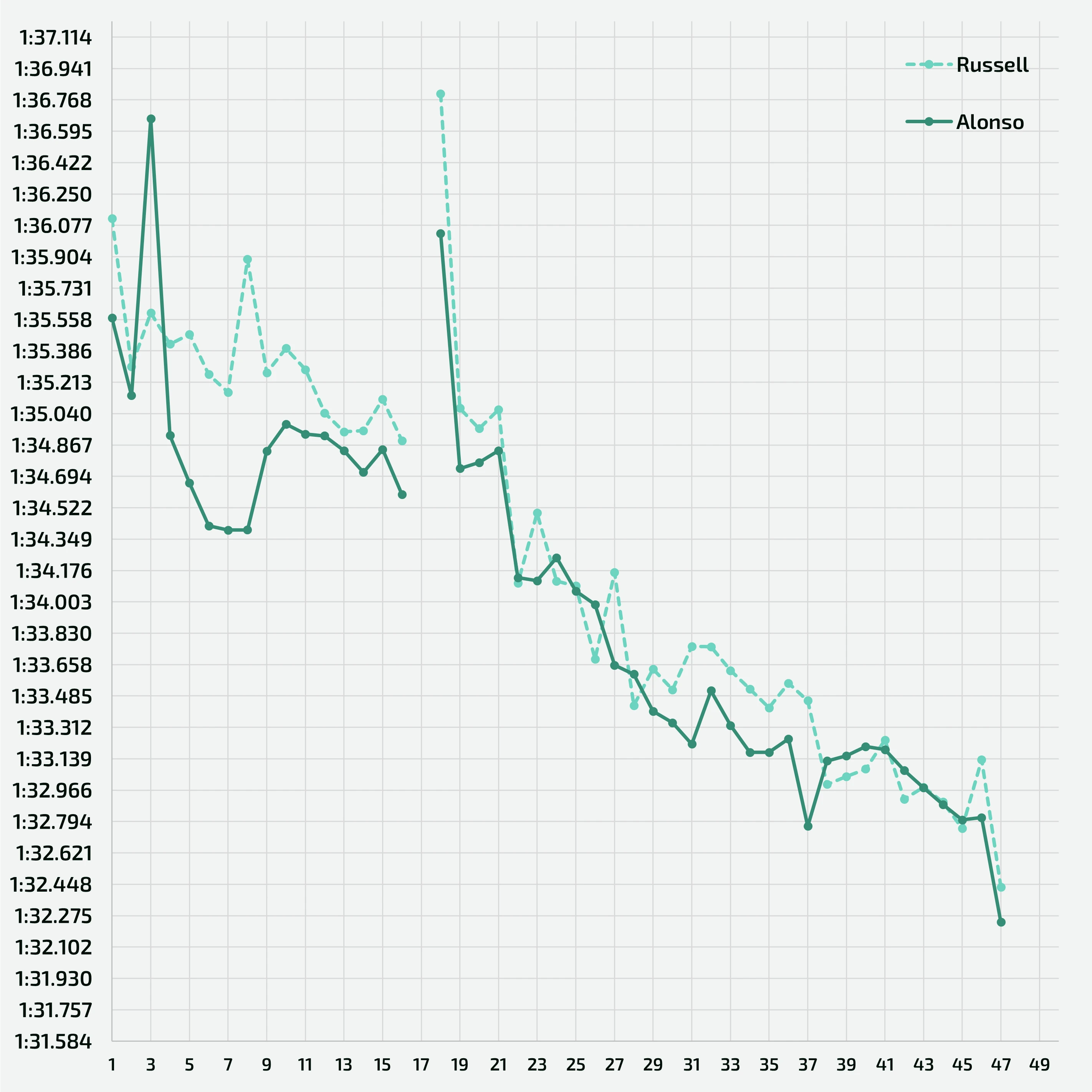
Laptime comparison between Fernando Alonso and George Russell
During the Safety Car period Alonso was forced to serve a 5 s time penalty for incorrect positioning on his grid slot at the start, exactly as happened to Esteban Ocon during the last Bahrain GP.
Once the penalty had been served, only after more than 30 minutes of the race the Federation started an investigation into the procedure for how the penalty itself had been served, concluding that the mechanics in the pits had touched Fernando's AMR23 before the 5 seconds. For this reason, they decided to impose another 10-second penalty on the Spanish driver, to be added to the race time.
Zak Mauger / Motorsport Images
A few hours after the end of the race, however, they changed idea another time (as reported by our italian colleagues of FuoriTraiettoria): Alonso maintains a special third place, being the 100th podium in his career in Formula 1!
Russell himself, who for a few hours believed he had secured third place in the Saudi Arabian GP, showed true sportsmanship in declaring how superior was Fernando's performance shown on the track…
"It's not my podium today, it's Fernando's podium. I think the penalty was very severe against him, he deserved to be there and to have the trophy. I was also satisfied with fourth place, ahead of both Ferraris and after a great qualifying, I think we went beyond the car's potential this weekend, we really couldn't do more"
George Russell
So far we have not talked in detail - deliberately - about the race of the two Ferrari SF-23s of Sainz (P6) and Leclerc (P7). In fact, I believe that the situation in the Maranello team deserves another dedicated blogpost, which will be available in the next few days.
For now, in order to provide a complete analysis of the GP, you can find below the laptimes of the two Ferraris in relation to those who finished ahead of them (Russell and Hamilton, respectively fourth and fifth) and those behind (Ocon, eighth).
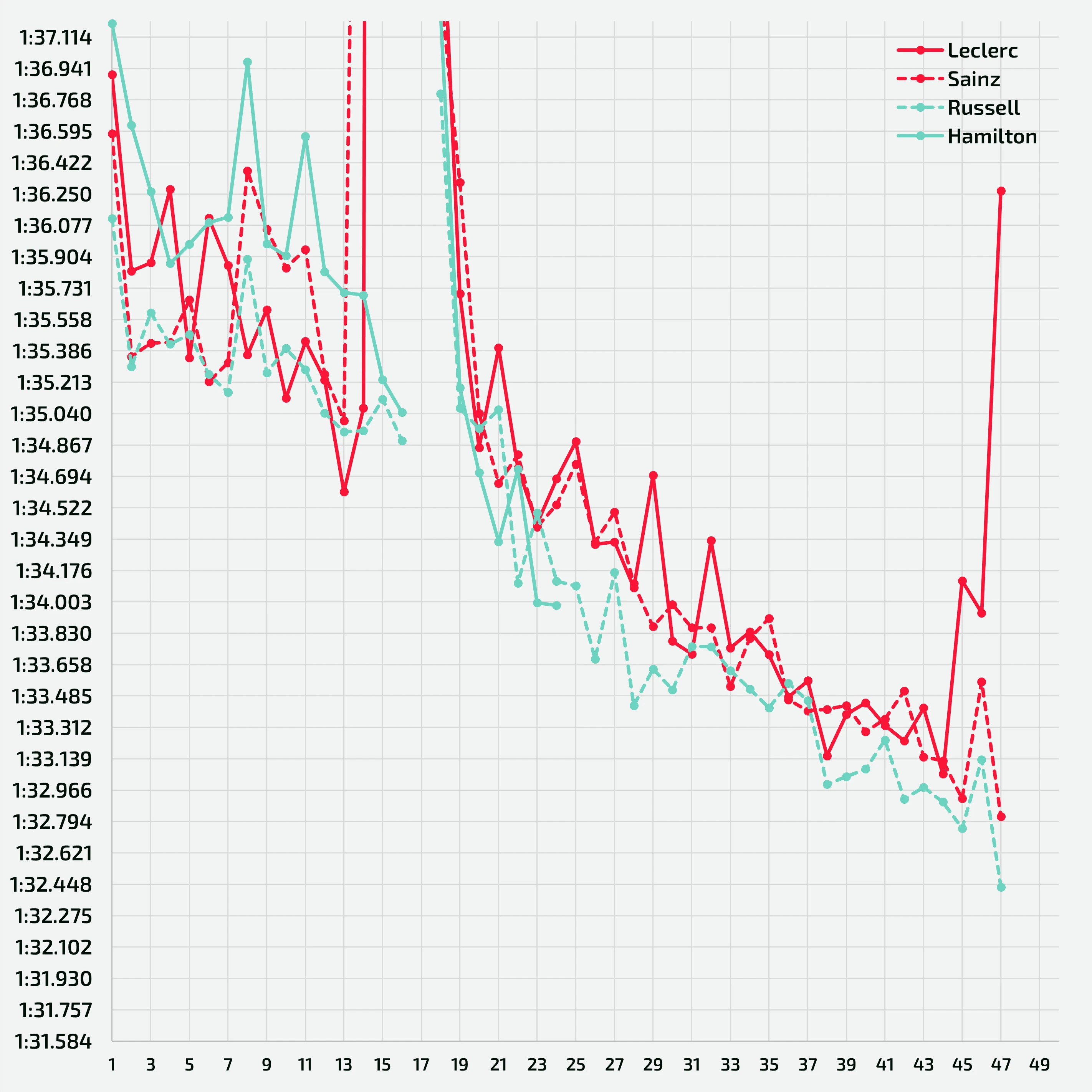
Laptime comparison between Russell, Hamilton, Sainz and Leclerc
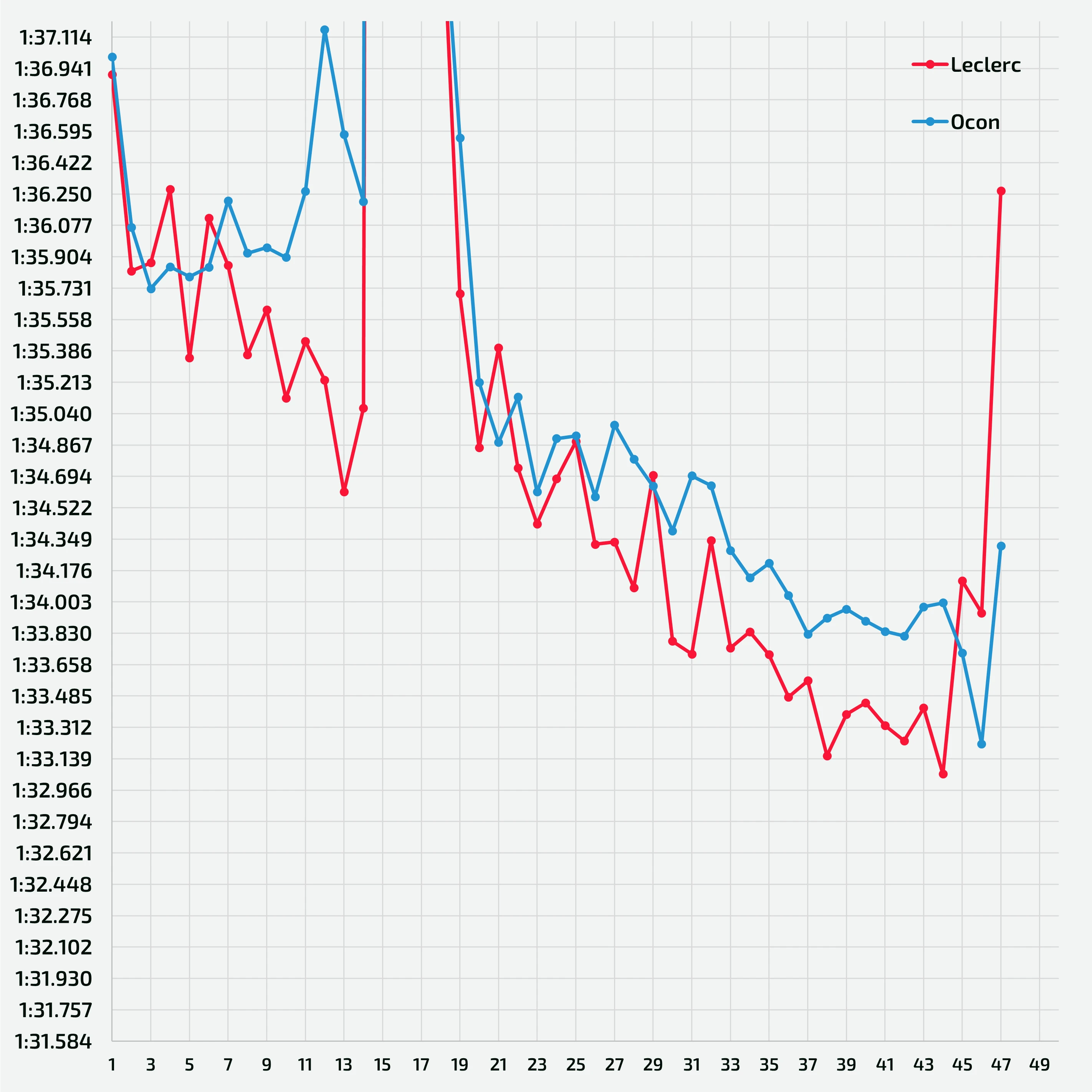
Laptime comparison between Charles Leclerc and Esteban Ocon
In short, the data extracted from the graphs above reflect the positions obtained by Ferrari, who at the moment can be considered the fourth fastest car in an established way.
What can we expect in the next Australian GP?
Formula 1, as we know, never stands still: in two weeks time the teams will be back on track for the third round of the season, in the historic setting of Melbourne. I find it likely to expect the performance levels to be fairly unchanged compared to what we saw in the first two races, even if Albert Park has a very different layout compared to both Sakhir and Jeddah.
Zak Mauger / Motorsport Images
As always, if you found this article interesting, please share it! I also remind you that I'm on Instagram and Twitter to discuss Formula 1 live. See you next time!
Index
Perez and Verstappen annihilate the competition in the race in Jeddah. Ferrari from bad to worse…